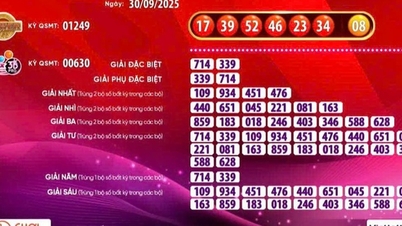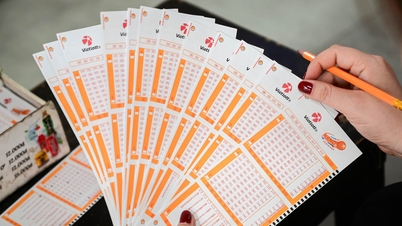Pull to dump, cash flow exhausted
The stock market on October 30 started with a lot of tension. Right from the opening hour, the red color quickly covered the electronic trading board. However, buying and selling activities were quite cautious. There were no significant sell-offs or bottom-fishing waves. Investors showed a wait-and-see attitude.
Throughout the morning session, VN-Index fell steadily, without significant fluctuations. The “steady decline” continued until the early afternoon session. However, at 2 p.m., strong buying pressure suddenly appeared, helping VN-Index limit its decline. Many optimists thought of a scenario where VN-Index would regain green in a spectacular way.
However, the stock market session on October 30 quickly revealed the “pull to dump” scenario. That is, the VN-Index was pulled to the “peak” zone during the session but then quickly fell sharply because of the sudden and massive supply.

The stock market session on October 30 witnessed another negative performance of the VN-Index. The phenomenon of "pull to dump" at the end of the session caused investors to suffer heavy losses. Illustrative photo
At the close of the stock market session on October 30, VN-Index decreased by 18.22 points, equivalent to 1.72% to 1,042.40 points; VN30-Index decreased by 19.94 points, equivalent to 1.87% to 1,047.63 points.
In the stock market session on October 30, the entire Ho Chi Minh City Stock Exchange had only 111 stocks increasing in price, 56 stocks remaining unchanged and 393 stocks decreasing in price (49 stocks hitting the floor).
One of the highlights of the October 30 stock market session was the dry flow. Only 533 million shares, equivalent to VND10,128 billion, were successfully traded. The VN30 group had 166 million shares, equivalent to VND4,603 billion, transferred.
The stock market session on October 30 saw blue-chips play a significant role in “sinking” the VN-Index. However, there were still 4 stocks that successfully “overcame the storm”. BCM increased by 500 VND/share, equivalent to 0.85% to 59,500 VND/share; MSN increased by 200 VND/share, equivalent to 0.35% to 58,000 VND/share; VCB increased by 900 VND/share, equivalent to 1.06% to 85,900 VND/share and VRE increased by 200 VND/share, equivalent to 0.87% to 23,100 VND/share.
Meanwhile, the stock market on October 30 witnessed a floor fall in technology retail stocks, public investment, real estate, etc. DGW decreased by VND3,350/share to VND45,200/share; ELC decreased by VND1,450/share to VND19,700/share; FRT decreased by VND6,400/share to VND86,400/share;...
On the Hanoi Stock Exchange, the indices fell even faster than the VN-Index and VN30-Index. At the close of the October 30 session, the HNX-Index fell 6.7 points, or 3.07%, to 211.34 points; the HNX30-Index fell 26.16 points, or 5.85%, to 420.94 points.
Asian markets in turmoil
Asia- Pacific markets started the week mixed ahead of key economic data from across the region.
Monetary policy decisions from Japan and Malaysia, inflation data from South Korea and overall domestic growth figures from Taiwan and Hong Kong are regional highlights for the week.
Japan's Nikkei 225 fell 0.95% to end the day at 30,696.96, as the Bank of Japan began a two-day monetary policy meeting, while the Topix lost 1.04% to close at 2,231.24.
In contrast, South Korea's Kospi rose 0.34% to end at 2,310.55 and the small-cap Kosdaq closed up 1.15% at 757.12.
In Australia, the S&P/ASX 200 index fell 0.79% to 6,772.90, as the country's September retail sales rose faster than expected.
Hong Kong's Hang Seng index fell 0.08% in the previous hour, while mainland China's CSI 300 index ended the day up 0.6% at 3,583.77.
On Friday in the United States, all three major indexes ended the trading day mixed, with the S&P 500 entering correction territory as Wall Street continued to sell off on recession fears.
The 30-stock Dow Jones Industrial Average fell 1.12%, while the S&P 500 fell 0.48%. Meanwhile, the Nasdaq Composite rose 0.38% to 12,643.01, helped by Amazon beating analysts' expectations for revenue and earnings in the third quarter.
Source


![[Photo] The 1st Congress of Phu Tho Provincial Party Committee, term 2025-2030](https://vphoto.vietnam.vn/thumb/1200x675/vietnam/resource/IMAGE/2025/9/30/1507da06216649bba8a1ce6251816820)
![[Photo] Solemn opening of the 12th Military Party Congress for the 2025-2030 term](https://vphoto.vietnam.vn/thumb/1200x675/vietnam/resource/IMAGE/2025/9/30/2cd383b3130d41a1a4b5ace0d5eb989d)

![[Photo] Panorama of the cable-stayed bridge, the final bottleneck of the Ben Luc-Long Thanh expressway](https://vphoto.vietnam.vn/thumb/1200x675/vietnam/resource/IMAGE/2025/9/30/391fdf21025541d6b2f092e49a17243f)
![[Photo] General Secretary To Lam, Secretary of the Central Military Commission attends the 12th Party Congress of the Army](https://vphoto.vietnam.vn/thumb/1200x675/vietnam/resource/IMAGE/2025/9/30/9b63aaa37ddb472ead84e3870a8ae825)
![[Photo] President Luong Cuong receives President of the Cuban National Assembly Esteban Lazo Hernandez](https://vphoto.vietnam.vn/thumb/1200x675/vietnam/resource/IMAGE/2025/9/30/4d38932911c24f6ea1936252bd5427fa)

































































































Comment (0)